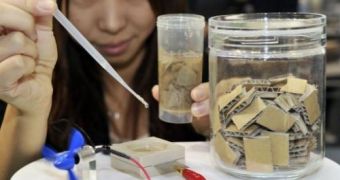Sony may have just come up with one of the most ambitious bio-battery projects to date, albeit one with rather unfortunate implications for the world's forests.
At least this is still a proof-of-concept, so lumberjacks needn't sharpen their axes just yet.
All jokes aside, though, what Sony envisioned is a battery that runs primarily on paper, or cellulose if one is to be precise.
The bio-battery demonstrated so far involved a mixture of water and enzymes that break the paper into that very cellulose.
Both shredded paper and pieces of corrugated board work for the process.
With the paper to provide the cellulose, the enzymes in the solution break down the long chain of glucose sugar (that is what cellulose is) and let another batch of enzymes pick apart the resulting substance.
The end of the reaction leaves behind hydrogen ions and electrons.
The latter travel through an outer circuit and generate the electricity, while the hydrogen ions mix with the oxygen in the air and form water (H2O vapors basically).
The demonstrated battery was able to provide a small fan with enough energy to run.
“This is the same mechanism with which termites eat wood to get energy,” said Chisato Kitsukawa, a public relations manager at Sony. “Bio batteries are environmentally friendly and have great potential.”
Still an experimental technology, there is no way anyone will find paper batteries on shelves or online any time soon, not in 2012, probably no for several years in fact.
It will be useful if Sony is able to make it so that they can work with used paper, though, like newspapers, old worn books, etc.
Not too great a chance exists for that of course (whatever ink or chemicals are present will mess up the reactions after all) but it is still a promising dream to hold onto.

 14 DAY TRIAL //
14 DAY TRIAL //